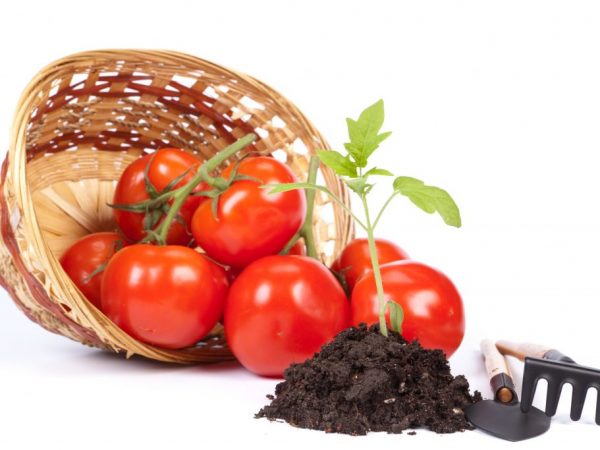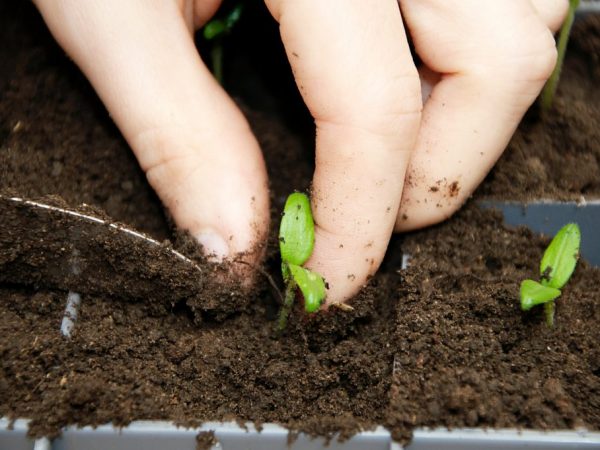How can you feed tomatoes after picking
Correct introduction of planting material into the soil and care for young sprouts is the key to obtaining a good tomato harvest in the future. Before planting in the ground, the seedlings should receive fertilization several times. Before replanting, the soil is not fertilized. Many gardeners are tormented by the question of how to feed tomatoes after a pick and how to carry out subsequent care.

Top dressing of tomatoes after picking
When crops are deficient in vitamins
If you are wondering how to feed tomato seedlings after a pick, when the leaves began to wither, you should learn to determine what substances the plants lack for full development. An excess of nutrients, as well as a deficiency, will negatively affect growth and productivity. What substance to feed tomato seedlings after a pick is not difficult to figure out by external signs:
- if the leaves begin to turn yellow and wither, it means that there is not enough nitrogen in the ground, in which case the tomato should be fed with ash;
- purple leaves indicate a lack of fluoride;
- pallor of greenery indicates a lack of iron in the soil;
- if the stem becomes brittle, and quickly breaks when touched, there is not enough magnesium and calcium in the soil, it is recommended to feed the plant with chalk;
- if growth has slowed down, sodium humate or deciduous humate should be added.
If there is a lack of fluoride, it is better to feed the tomatoes after picking with an egg solution. The acidity of the soil is increased with the help of a decoction with ash. With an excess of fertilizers, the foliar part of the plant begins to grow rapidly; in such cases, superphosphates are used, which accelerate the growth of the root system. If the rhizome is not well developed, the plant will not have the strength to form flowers and ovaries, which can significantly reduce the yield.
How to choose biofertilizer
"How to feed tomato seedlings after picking?" - the main question in which opponents of chemical fertilizers are interested. You can feed tomatoes after picking with the following factory fertilizers:
- potassium sulfate;
- saltpeter;
- urea;
- superphosphates.
In private farms, they usually contain all kinds of animals. The waste products of poultry and animals can be used as fertilizer. In addition, feeding tomato seedlings after picking can be carried out using solutions based on ash, yeast, eggshells, iodine. Some gardeners often use banana skins, onion skins, and coffee grounds to make fertilizers. All these variations are completely natural and you can make solutions yourself at home.
Self-made biofertilizers

An excellent fertilizer can be made from eggshells
For the manufacture of egg feeding, you need about 300 g of shells. It should be placed in a three-liter jar and filled with water. The mixture should be placed in a warm place for several days.When the mass starts to emit an unpleasant odor, it is ready to use. The resulting solution is diluted with water for irrigation in proportions of 1: 3.
An infusion with ash is best suited to accelerate growth and prevent all kinds of diseases. A tablespoon of ash is placed on 2 liters of water, insisted for a day. The resulting mixture should be filtered. Do not use ash from burning plants that have been infected with fungus. In combination with ash, chalk and iodine are used.
Poultry droppings are used to regulate the acid-base balance of the soil. For example, purple tomato varieties will turn pink if there is little acid in the soil. When planting, bird droppings are placed in each hole to prevent pests such as whitefly, cabbage, etc. Onion husks are a universal remedy. The husk decoction is used not only for feeding, but also as a prophylaxis for viral diseases.
You can feed the tomatoes after picking with a yeast solution. Put 10 g of yeast on 10 liters of water, stir, and then water the tomatoes. Previously, the use of this remedy was very popular, but over time and the advent of newfangled drugs, it was forgotten, and in vain. Yeast fungus helps to activate the development of microorganisms in the soil, which improve the quality of the soil and prevent the spread of fungal infections. Iodine or manganese is added to water for irrigation as a prophylaxis against all kinds of diseases, if there is a risk of infection, as well as to increase the yield of tomatoes.
Ground part care
Plants can be fed not only through the root system, but also through the ground part. The foliar system also needs fertilization after a dive. Such manipulations are carried out in combination with rhizome fertilization, alternating procedures with each other. It is recommended to feed the ground part of the tomatoes in the early morning, when the dew has not yet melted.
For feeding the ground part, the same fertilizers are used as for the root system. The most popular are spraying with superphosphates, urea solutions, phytosporin. From folk remedies, you can use spraying with a decoction of nettle leaves. In order to prevent fungal diseases and pest infestations, the upper part of the plants should be fed with iodine solution or garlic infusion. It is not recommended to use nitrate solutions because it is a rather toxic substance and its use can negatively affect the state of the soil and human health.
Stimulant drugs
There are many stimulating drugs that are completely harmless to humans and plants. These include, for example, sodium humate. This substance is not mutagenic, non-toxic, 100% safe for human health and the environment. The main active ingredient is the mineral salts of humic acids. They allow you to strengthen the immunity of the plant, accelerate the growth of tomatoes.
Mineral fertilizers are another option for high-quality, harmless top dressing for tomatoes. There is a sufficient amount of mineral fertilizers on the market. Read the instructions carefully before using them. If used improperly, the root system of tomatoes can be damaged. The first feeding should include nitrogenous compounds, this will help to quickly form a full-fledged root system and ground part.
Rules for the implementation of the procedure

The seedling root system needs fertilization
When to feed tomatoes after picking for the first time? The transplant is usually carried out in 7-12 days. At this point, the sprouts have 2-3 leaves. Although the seedlings appear to be strong, the stem and root system need additional stimulation when replanting to better adapt to the new soil.
The first feeding of tomato seedlings is carried out immediately.The plant will respond to stress during transplanting anyway, so it needs to be helped to adapt through fertilization. Picking tomatoes and simultaneous feeding allows you to develop a protective mechanism and form a completely root structure, which is the key to quick adaptation in the open field. Do not forget that an excess of fertilizer can negatively affect yields. The plant will begin to actively build up the ground part to the detriment of the rhizome, that is, all forces will be directed to the formation of new shoots, not ovaries.
A plot of open ground should not be fertilized right before transplanting tomatoes into it, but the soil should be prepared in the fall, from the moment of harvesting. After harvesting, it is necessary to completely remove all the remnants of the plants, burn them. Ash can be scattered around the site. Then the soil is cultivated, compost is introduced. In the spring, you need to dig up the soil again, and a month before planting the tomatoes, apply mineral or organic fertilizers.
Biofertilizer application schedules
In what conditions is it better to fertilize tomatoes? Seedlings of various varieties in open ground are planted at different times, but feeding tomato seedlings after picking is carried out at approximately the same time interval:
- in the first 24 hours upon transfer;
- the second in 10-15 days;
- the third time a month after the transplant;
- the last time a couple of days before planting in open soil.
The first feeding of tomato seedlings after picking is urea. It helps to improve the condition of the sprouts and accelerates their growth. It is in the first month after sowing the tomato that the rhizome begins to actively develop, but the main task of feeding during the dive is to ensure the growth of the ground part. The main thing is not to overdo it with fertilization, otherwise the growth of greenery will occur to the detriment of the root system. A tablespoon of urea is placed on 10 liters of water and the plant is watered abundantly.
For the second time, the soil is fertilized according to the same scheme, for the third time it is fertilized with minerals, most often nitrophosphate is used. A tablespoon of the substance is placed on 1 liter of water. Many summer residents use folk fertilizer recipes. Such methods are completely safe and economical.
Top dressing of tomato seedlings, carried out after picking, is not the only factor that will affect the growth and immunity of the plant in open soil. In addition, it is necessary to carry out work with the seedlings to adapt to outdoor conditions. A month before this procedure in open ground, you should begin to harden the plants and accustom them to direct sunlight. Do not be zealous with watering, otherwise the risk of getting fungal infections increases.


